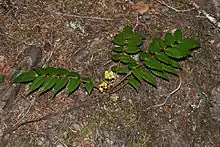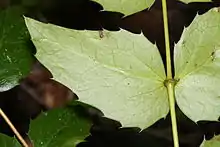Mahonia nervosa
Mahonia nervosa, commonly known as dwarf Oregon-grape, Cascade barberry, Cascade Oregon-grape, or dull Oregon-grape, is a flowering plant native to the northwest coast of North America from southern British Columbia south to central California, with an isolated population inland in northern Idaho.[4][5][6] It is especially common in second growth, Douglas-fir[7] or western redcedar forests, making use of those pools of sunlight that intermittently reach the ground.
| Dull Oregon-grape | |
|---|---|
 | |
| Scientific classification | |
| Kingdom: | Plantae |
| Clade: | Tracheophytes |
| Clade: | Angiosperms |
| Clade: | Eudicots |
| Order: | Ranunculales |
| Family: | Berberidaceae |
| Genus: | Mahonia |
| Species: | M. nervosa |
| Binomial name | |
| Mahonia nervosa | |
| Synonyms[1] | |
Some authors place the entire genus Mahonia within the genus Berberis.[8][9][10]
The plant was collected by Lewis and Clark during their famous expedition to the West before being described for science in 1813.[11][12]
Description

It is an evergreen shrub with short vertical stems, mostly under 30 cm (12 in), while the leaves reach higher, rarely up to 2 m (6 ft 7 in) tall. The leaves are compound, with 9–19 leaflets; each leaflet is strongly toothed, reminiscent of holly, and somewhat shiny, but less so than tall Oregon-grape. The leaflets do not have a single central vein as in that species, but several veins arranged fan-like, branched from the leaflet base, hence the epithet nervosa. The flowers and fruit are like those of other Oregon-grapes, and are equally sour-tasting.
Uses
Some Plateau Indian tribes drank an infusion of the root to treat rheumatism.[13] The Yana people dried and ground the fruits to make a mush. They can also be dried and eaten like raisins.[14]
References
- Tropicos
- Roof, James B. Four Seasons 3(1): 8–10, f. s.n. [p. 9, upper right]. 1969.
- Roof, James B. Changing Seasons 1(3, Suppl.): 14. 1981.
- Hickman, J. C. 1993. The Jepson Manual: Higher Plants of California 1–1400. University of California Press, Berkeley.
- Munz, P. A. & D. D. Keck. 1959. California Flora 1–1681. University of California Press, Berkeley.
- Hitchcock, C. H., A.J. Cronquist, F. M. Ownbey & J. W. Thompson. 1984. Salicaceae to Saxifragaceae. Part II: 1–597. In C. L. Hitchcock et al. Vascular Plants of the Pacific Northwest. University of Washington Press, Seattle.
- Pojar, Jim; MacKinnon, Andy, eds. (1994). Plants of Coastal British Columbia: including Washington, Oregon & Alaska, rev. ed. Vancouver: Lone Pine Publishing. p. 95. ISBN 978-1-55105-532-9.
- Loconte, H., & J. R. Estes. 1989. Phylogenetic systematics of Berberidaceae and Ranunculales (Magnoliidae). Systematic Botany 14:565–579.
- Marroquín, Jorge S., & Joseph E. Laferrière. 1997. Transfer of specific and infraspecific taxa from Mahonia to Berberis. Journal of the Arizona-Nevada Academy of Science 30(1):53–55.
- Laferrière, Joseph E. 1997. Transfer of specific and infraspecific taxa from Mahonia to Berberis. Bot. Zhurn. 82(9):96–99.
- Fl. Amer. Sept. (Pursh) 219. 1814 [Dec. 1813]. Collectors: M.Lewis, W.Clark s.n. "Plant Name Details for Berberis nervosa". IPNI. Retrieved November 27, 2009.
- "Mahonia nervosa". Germplasm Resources Information Network (GRIN). Agricultural Research Service (ARS), United States Department of Agriculture (USDA). Retrieved November 27, 2009.
- Hunn, Eugene S. (1990). Nch'i-Wana, "The Big River": Mid-Columbia Indians and Their Land. University of Washington Press. p. 352. ISBN 0-295-97119-3.
- Nyerges, Christopher (2017). Foraging Washington: Finding, Identifying, and Preparing Edible Wild Foods. Guilford, CT: Falcon Guides. ISBN 978-1-4930-2534-3. OCLC 965922681.
External links
| Wikimedia Commons has media related to Mahonia nervosa. |